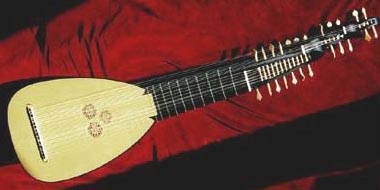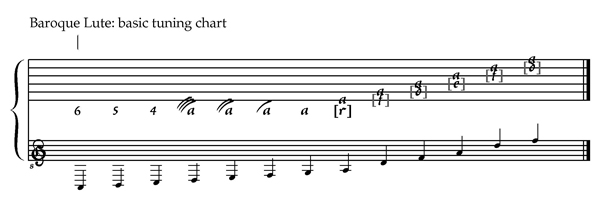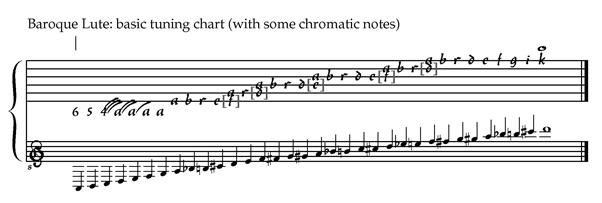SO YOU WANT TO PLAY A BAROQUE LUTE?
The 13-course Baroque Lute is an instrument of beauty and refinement, possessing some of the most beautiful soloistic literature among all the plucked stringed instruments. It is essentially an instrument of PRIVATE performance: it is NOT designed to please large audiences and halls.
It blends well with human voice and is very effective in Lieder accompaniment, but it is not well-suited for chamber ensemble musicmaking, notwithstanding some very fine chamber music with obbligato lute extant. It is at its best when played for oneself, or a few of the chosen.
The most common tuning system for Baroque Lute, beginning with the highest string:
FDAFDAGFEDCBA for a 13-course instrument,
TABULATURE is the most practical (and the most typical) method for notating lute music. It is the form of all musical material found in these pages:
In standard Baroque lute tabulature, each staff has six lines, representing the FIRST six courses. The course of the highest pitch appears at the top, and that of the lowest appears at the bottom. Please note that Italian Archlute of the same period uses an opposite system. Do not mistake these instruments and their respective repertoires, even if the music is of similar style.
F____________________
D____________________
A____________________
F____________________
D____________________
A____________________
Lower case letters or "glyphs"are placed on each of these lines to represent notes. If you are required to play an open D course, for instance, a small "a" will be placed on the appropriate line. For a note with the finger on the first fret a "b", a note on the second fret a "c", etc. The 2 exceptions to this are that no "j" is used, as it was considered to be too similar to "i", and the Greek "Gamma" is usually used in place of "c" to avoid any resemblance to "e". So:
F_____c___
D_____a___
A_____b___
F_____c___
D_____a___
A_____b___G - a
would represent a G-minor chord,
All open strings would represent a D-minor chord.
F______a________
D______a________
A______a________
F______a________
D______a________
A______a________D- ///a
The strings below the 6th course are notated with additional short "ledger" lines: glyphs are placed below the staff.
These courses are tuned in accordance with the key of each piece played:G- a
F- /a
E- //a
D- ///a
C- 4
B- 5
A- 6
The rhythm is notated in a fairly straightforward manner: It is represented by headless note-stems with tails
[stylized similarly but some regional variations (in spite of some variety the confusion is rare)],
with the exception of whole and half notes, whereas it would be essential to use heads.The ornaments would require a special discussion, as many composers used rather personalized sets of these.
There is a misconception that Baroque Lute is an extremely difficult instrument to learn and play. However exactly the opposite is true:
in spite of it's size and the staggering number of strings Baroque Lute is a lot more ergonomic than its Renaissance cousin, largely owed
to the fact that its music is generally set up in such a way as to maximally utilize open strings in scales and passages, and cross-string
movements: rarely more than 3 consecutive notes are played on the same string. In short: it requires a lot less physical labor than
all other plucked instruments.This is what a Baroque Lute sounds like: Played by this writer (far from ideal, 3mb)...
You will find the history of the lute with many images of surviving old lutes HERE.
You will find a great quantity of scores for Baroque Lute HERE.If you, the reader of this, are interested in actually owning and playing a lute: you should visit Wayne Cripps' site here (there are many
lutes for sale listings) before taking any actions in this direction:http://www.cs.dartmouth.edu/~wbc/lute/lute.html
Please be aware that the Baroque Lute is absolutely useless in older lute music popular with guitarists, such as Francesco da Milano or John Dowland.
It is only usable in the appropriate musical period, i.e. in music from about 1640 to about 1800, with some later exceptions of contemporary retrocomposition.
There is no such thing as all-purpose lute. This writer advocates dedicating oneself to a single instrument and era, for best and most rewarding results.The most common problems encountered by are stabilizing the lute's rounded body on one's lap, or chest: it is easily solved with a strap tied in a specific way -
and teaching one's thumb to find basses securely. This is usually impeded by a wrong choice of bridge spacing, as inexperienced novices opt for
too narrow one, usually in the vicinity of 140-145mm, and this cannot be undone without major bridge surgery, so people get stuck with an instrument
they cannot play, and get easily discouraged. A comfortable bridge spacing is more like 155mm for a 13course lute.The renaissance lute may be an easier choice for some (with only generalized interest in the Lute), for two reasons. First, of
all the lute tunings/stringing configurations (of which there are considerably more than just two: renaissance, d minor baroque, Italian
theorbo, English theorbo, gallichon, and a number of "transitional" tunings between renaissance and d minor baroque for which there is a
substantial repertoire) the renaissance tuning is most familiar to the guitarist.* *OK, not necessarily true: the stringing and tuning for the
18th-century German 8-course instrument called the gallichon/mandore/colachon is most like the guitar's, but there isn't a lot of solo music
extant for it, and the gallichon and its music are not well known. It still might be a practical option for some guitarists wishing to make an easier
transition into the world of Baroque Music. Some guitarists do very well transferring to Theorbo, because it is single strung, and best played with
nails. Theorbo's soloistic literature is not large, however. It was mainly intended for accompaniment. Many beginning lutenists also tend to opt for
smaller lutes, usually in the 55-62cm range. In my opinion it is much easier to obtain a good sound from a lute with a longer string length, in the
65-68cm range, as smaller lutes' acoustic setup tends to make errors and choked notes come out, while longer lutes smoothout the imperfections.
Many (but not all) baroque lute players become conversant in renaissance tuning first (there are even some who have no guitar experience, most
notably this writer and Lynda Sayce of the King's Consort). Any guitarist can tune the third string down to F# and read RENAISSANCE tabulature
right off the page. Unlike a lot of other tunings, renaissance tuning is practicable with a relatively small number of courses -- as few as six, by
which I mean there is a great deal of music written in that tuning for only six course lutes. (Also a lot of music for seven and eight courses, less
for nine, quite a bit for ten, and some for 14-course archlute). HOWEVER, this tuning is entirely useless in post-1650 lute music: Bach, Weiss, Hagen,
Sautscheck I-VI, Kohaut, Haydn, etc. Such music requires D minor tuning, which starts with a minimum of 11 courses (i.e. the music in that tuning
assumes at least 11 courses).There are many types of shells used in Baroque Lute construction. My preference is for very shallow ones of the Edlinger/Tiffenbrucker type,
as these are a good deal easier to hold firmly, they create a lot less strain on the left shoulder, and have better projection. Sylvius Leopold
Weiss preferred this type himself. I also prefer playing standing up, with a strap. This helps reduce back strain and leg circulation problems.
Another important point is the bridge spacing (see above). It is recommended to have a distance of 15.5cm (155mm) between the top and
the bottom strings, even if you have small hands. This bridge spacing allows one to cleanly navigate bass strings with one's thumb.My friend Howard Posner wrote this on the Lute-Net, in responce to some questions from a newbie:
"....Let me offer a few thoughts.
1. Be skeptical about everything you read about the lute in
20th-century sources. There's some good stuff, of course, but also a
lot of surmise and a lot of reasoning backward from unlikely
conclusions, as in, "Michel Pudolski's playing in 1970 (or Arnold
Dolmetsch's playing in 1930) represents the historical lute; he sounds
pretty bad, therefore the lute must be a difficult instrument to play."
Historically, I can't think of anyone other than Mace who felt
compelled to defend the lute against charges of difficulty, and the
instrument was around more than a century after him.2. There's nothing all that difficult about the lute. It's a piece of
cake compared to the baroque trumpet. Even I can play it decently on a
good day. True, my last good day was during the Clinton years, but you
get the point. There's some lute music I wouldn't even attempt, but
that doesn't make lute music generally too difficult. Not every
violinist can play Paganini.3. A growing virtuoso literature does not cause an instrument to
decline; rather it's a sign that there's a growing number of virtuosos,
representing, one would think, the growing tip of a growing iceberg of
competent but non-virtuoso players.4. If increased difficulty causes an instrument's extinction, the lute
would have gone the way of the pteranodon before 1600. The instruments
got bigger and more complex, but I don't think the music got
intrinsically more difficult in the 18th century.5. The reasons for the lute's disappearance from European art music
are not simple, especially since it may not have disappeared from every
place at the same time for the same reason. There are all kinds of
trends you can look to: I think the movement of music out of
aristocratic drawing rooms and into larger public spaces, and the
decline of basso continuo and rise of keyboard-specific written-out
accompaniment, would have moved the lute from the mainstream to the
margin. Perhaps the lute was associated with an aristocracy that was
becoming an endangered species after the French Revolution. The last
thing I would look to is something inherent in the solo music, which is
what most players think of these days, but was only a part of what lute
players did when the lute was contemporary with its music."
So if all you want to do is play French or German baroque music, it is a waste of time to start with renaissance
tuning. But few players make this decision when they're starting out. You should know what you are getting into. The world of Lutes is
complicated. It is important to acquaint oneself with the recordings of the masters. Lutenistic practice reached considerable heights in
recent years.
So, having considered everything, you are buying your first baroque lute, used. There are some things one need to look at in an instrument offered for sale,
to minimize potential heartbreak:0. Don't buy anything without consulting--even if only via Skype--with a professional. My checklist would be to make sure it is a real lute, with the strings up to date.
1. Look for cracks in the shell near the neck joint. These are dangerous, more than cracks near the endclasp, they also contribute to unstable tuning. Check for soundboard cracks, especially if associated with buzzes (perhaps indicating a loose bar).
2. Make sure the soundboard is concave, and not flat of even convex. The latter is a disaster. The concave soundboard keeps the the action low and gives sufficient space for plucking.
3. Make sure the bridge is not too narrow, ideally in the vicinity of 155mm between the 1st and the 13th course. If it measures only 145mm or 140 even - stay away. Your thumb will be very sorry, and rather useless. An 11course lute should have at least 130mm on the bridge, up to 135. Currently (as of January 2016) a company called Le Luth Dore' is marketing Chinese-made 13course lutes with bridge spacing of 140mm. While LLD's renaissance lutes are OK - I emphatically advise AGAINST their baroque ones for the reasons given above (Caveat Emptor!).
4. Playability - i.e., action. Make sure string action is at 3.5 and 4mm maximum at the 8th fret when the instrument is tuned to full tension. Comfortable action is essential - no matter how good the overall sound, if you can't play the damned thing, if you're fighting the instrument to get a good sound, you're putting in effort that distracts you from making music. While Hoppy Smith has preferred a high action over the years, I have always found that a huge roadblock to progress for beginning players. Sometimes the action is too low. One of students in Antwerp owned a baroque lute by Michael Lowe that had such a low action--and such a thin top--that playing at a volume above a whisper elicited a buzz. That is just not on for a beginner.
5. Sound, of course, though that's subjective. As with any plucked-string instrument, wolf tones or dead notes (step one in trying out a new lute is to play every note on the fingerboard, paying close attention to comparative resonance, e.g., the first course is nice and bright--except for that c-sharp on the 8th fret. Or with diapasons, the resonance of the basses (after taking potential stringing problems into account) is uneven.6. If it is a swan-neck lute: make sure the bass strings are on the same plain as all others. If not (i.e too high): the upper pegbox may be distorted. This may eventually pull the bridge off the soundboard.
7. It is advisable to buy lutes made in the same geographic area where one lives. They'd have more longevity. America has wild swings of humidity, so american glue jobs are more reliable in such a climate. Some European makers' lutes don't last long in the Western hemisphere (for example Magherini, Tumiati, Hasenfuss offen implode in the NorthAmerican climate). Also: a lot of luthiers are extremely loath to repair those instruments not of their own manufacture, so try to favor local makers for both used and new lutes.
8. There are a lot of overpriced instruments out there. A number of former enthusiasts are selling instruments they bought for $1200--or less--in 1980, and they're looking to get $3K or more for them now. I'm not against people making a profit, and if it's a great instrument, it might be worth it. But a number of the used lutes I've had occasion to play were dreadful. Similarly a lute made in Russia or Belarus may be selling on the secondary market for 4-5 times the price it had in the luthier's shop. Somebody selling a Paul Thompson, e.g., or a Richard Berg, for several thousand $s? Yeah, check it out. But a lute from the glory days of Donna Curry, that originally sold for $800 and they're now selling for $3K? Nope, doesn't get my recommendation.9.Also, even famous luthiers have their strengths and weaknesses. Nico van der Waals builds great baroque lutes. Top of the pops. But the Renaissance lute and small theorbo a friend had back in the day were such that I wouldn't have give you half the price he was asking.
10. If you really like the lute offered for sale, but it has fixable problems: ask the seller to either get those problems fixed - or to reduce the price by the projected cost of such repairs.
That's the sum total of our collective wit and wisdom. Good luck!



